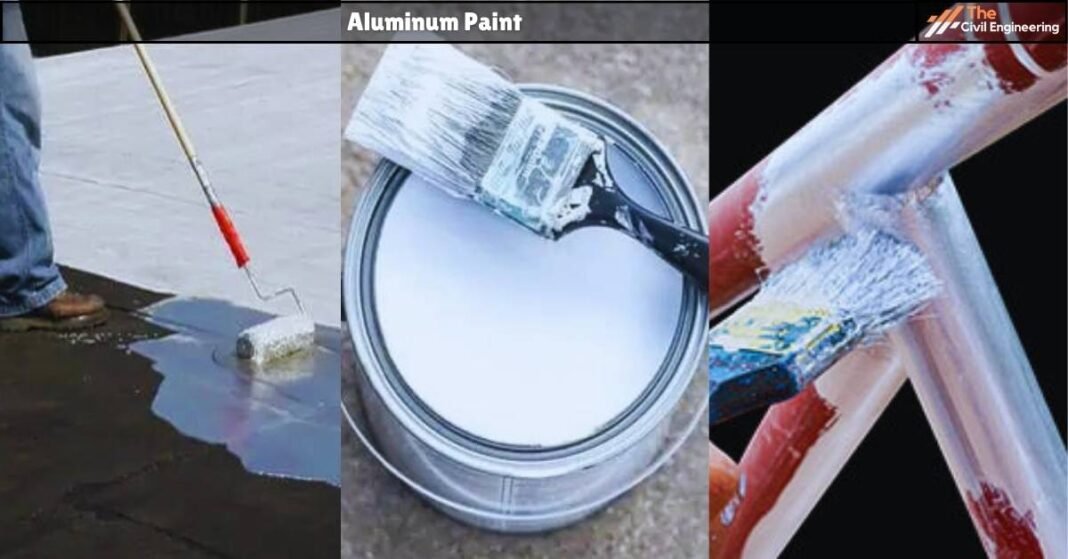1. Introduction
The aluminum paint is mostly used as a coating material essentially comprising of a mixture of oil varnish and pigment of aluminum in the form of thin flakes.
In a simple sense, the aluminums paint consists of a mixture of finely powdered aluminum.
The composition thus allows the paint film to reflect the radiation of the sun and to retain the heat in hot water tanks, pipes and furnaces.
The hardening of the aluminum paint layer is achieved through the evaporation of the oil.
The aluminums flakes present in the paint provides a shiny and metallic finish upon application of the paint.
The major application of such type of painting includes the painting of woodworks, metallic surfaces, etc.
2. Composition of
a. Base:
The base is one of the main components of paint and is also commonly referred to as the body of paint.
The base that is mostly used for aluminium paint is Titanium dioxide. It prevents the paint from cracking particularly shrinkage cracking.
b. Vehicle:
The vehicle is the constituent of paint that is basically composed of an oily liquid in which both the base and the pigment are soluble. The primary objective of the vehicle is to allow the paint to spread over the surface to which it is applied.
The vehicle that is used for aluminum paint is oil varnish. It is quite volatile in nature due to which it does not necessarily become a part of the paint.
c. Pigment:
The pigment is responsible for imparting the colour to the paint.
In other words, the pigment is the colouring material that is added to other constituents of the paint to impart the desired colour to the paint.
The primary function of the pigment is to hide the surface to which it is applied.
The pigments in the aluminium paint comprise fine mineral powders.
It also makes the surface opaque and glossy in nature.
d. Thinner/ Solvent:
Thinner is added to the paint with the objective of making the application of the paints easy, uniform and smooth. It is also used to adjust the viscosity of the paint.
Mostly, the mineral spirit is used as the thinner in aluminium paint.
e. Additives:
Additives may also be added to the paint to improve the properties of paint such as opacity, colour, dispersion of pigment, anti-freezing properties, corrosion-resistant properties etc.
Mostly driers are used as additives in aluminium paints.
3. Features of Aluminum Paint
Some of the features of aluminium paint can be listed as follows:
a. It has good protective properties namely heat resistance, thermal insulation and corrosion resistance.
b. It is durable and long-lasting in nature.
c. It imparts a silvery, metallic and shiny finish to the surfaces. This paint is usually manufactured in 1 litre, 4 litres, 5 litres and 20-litre packs.
4. Application of Aluminum Paint
The application of aluminium paint is relatively easy.
It can be applied easily by means of rollers, brushes, spray etc.
Upon application, the aluminium paint dries quickly.
Aluminium paint can be used for painting the masonry surfaces, metal surfaces, telegraphic towers, storage tanks, hot water pipes as well as wooden surfaces.
The aluminium paint must be applied in well-ventilated conditions and care must be taken so that there is no skin contact.
In case of accidental skin contact, the affected area must be cleaned immediately with soap, water or cleanser.
5. Advantages of Aluminum Paint
Some of the advantages offered by the aluminium paint are as follows:
a. It is water-proof, corrosion-resistant and weathering resistant in nature.
b. It is visible even in dark.
c. Such paint imparts an excellent silvery finish to the surfaces. Hence, can be used for painting both metallic surfaces and wooden surfaces.
| Read More: Defects in Painting |
| Read More: Emulsion Paint |


